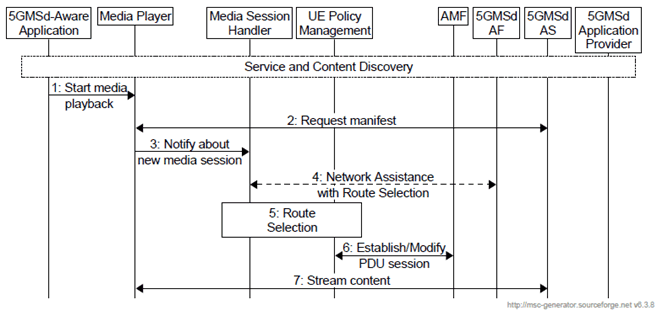Content for TS 26.501 Word version: 18.0.0
1…
4…
4.2…
4.2.2…
4.3…
4.5…
4.6…
4.7…
5…
5.2…
5.3…
5.3.2
5.4…
5.5…
5.5.3…
5.6…
5.7…
5.7.3
5.7.4…
5.8
5.9…
5.10…
5.10.5
5.10.6
5.11…
6…
6.2…
6.3…
6.5…
6.8…
7…
8…
8.2
A…
A.3…
A.5…
A.7…
A.9
A.10
A.11
A.12
A.13
A.14
A.15
B…
B.3
C…
C.3
C.4
C.5
D…
5.8 Dynamic Policy based on Network Slicing for Downlink Media Streaming p. 65
5.8.1 Procedure p. 65
The 5GMSd Application Provider requests the assignment of more than one network slice for the distribution of the service. The 5GMSd Application Provider indicates the desired network slice features that correspond to the Service Access Information. Upon successful assignment of the network slices for the service, the 5GMSd AF shall respond with the list of allowed S-NSSAIs to the 5GMSd Application Provider.
Figure 5.8.1-1 is the flowchart diagram for this procedure.

Figure 5.8.1-1: Dynamic Policy based on Network Slicing for Downlink Streaming
(⇒ copy of original 3GPP image)
(⇒ copy of original 3GPP image)
Pre-requisites:
- The UE knows how to access the network slice(s) associated with a particular Provisioning Session.
- The 5GMSd AS(s) serving the content for the particular Provisioning Session shall be accessible through the DNN(s) associated to the network slice(s) provisioned for the distribution of that content.
Step 1.
The 5GMSd-Aware Application triggers media playback by invoking the Media Player with the Media Player Entry for the selected content.
Step 2.
The Media Player requests the manifest from the 5GMSd AS.
Step 3.
The Media Player notifies the Media Session Handler about the upcoming media session and may request specific 5GMSd AF-based Network Assistance for that session, when not already established.
Step 4.
The Media Session Handler retrieves information from the 5GMSd AF to assist with the route selection for the session. This may include information about the network slices, the DNNs, any pre-authorized QoS guarantees for that Provisioning Session. The Media Session Handler gets information about the operation point selection from the Media Player as described in step 4.
Step 5.
The Media Session Handler and the UE Policy Management in the UE perform the route selection procedure using information such as the playback operation point, the traffic descriptors. The UE Policy Management will use the matching filter to retrieve the Route Selection descriptor, which provides the DNN, and the S-NSSAI(s), identifying the network slice(s) to be used for this Provisioning Session.
Step 6.
The UE reuses an existing PDU session with the selected S-NSSAI and DNN from step 5, or requests the establishment of a new PDU session with the identified parameters, if one doesn't exist already.
Step 7.
The streaming of the media content at the target operation point starts.